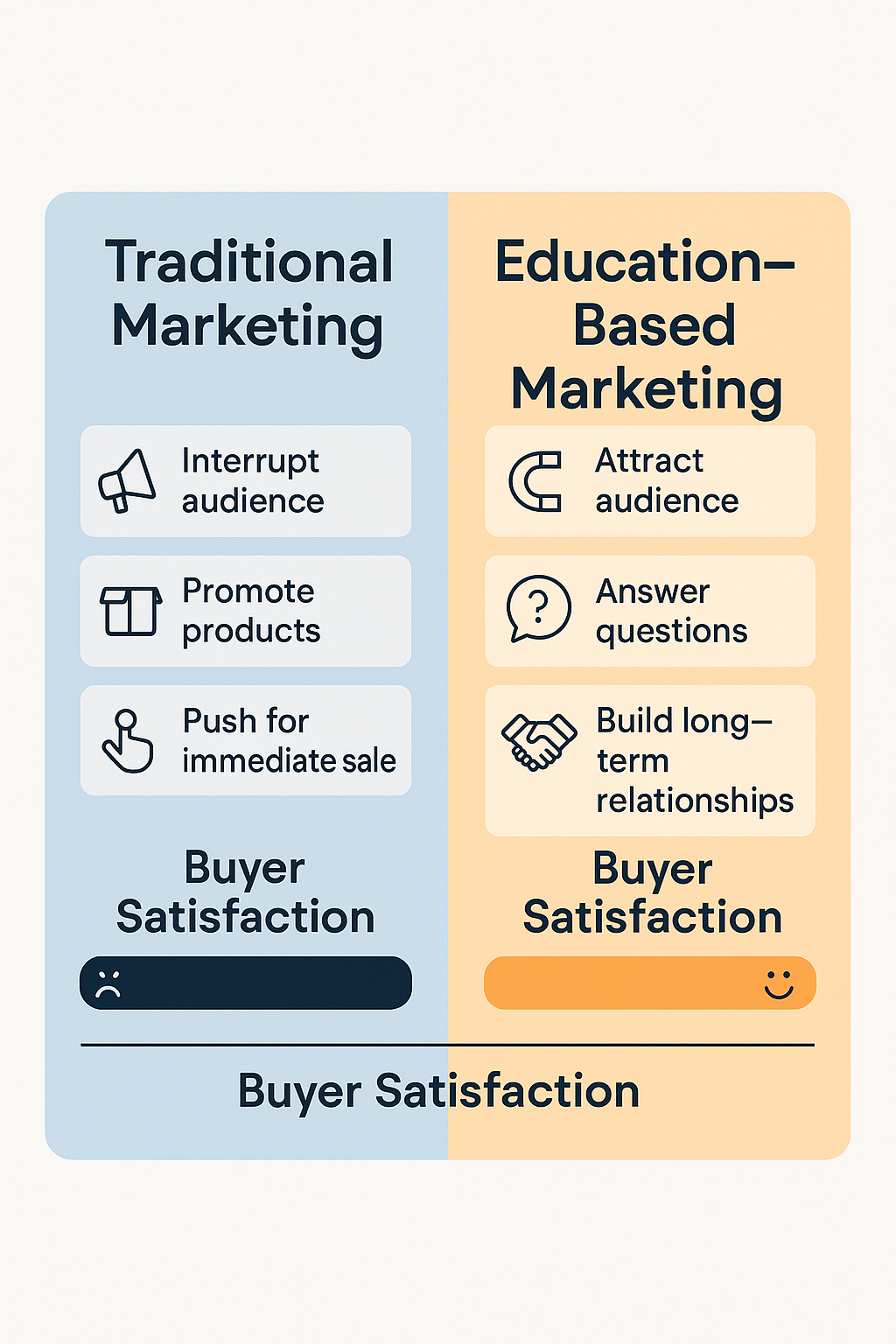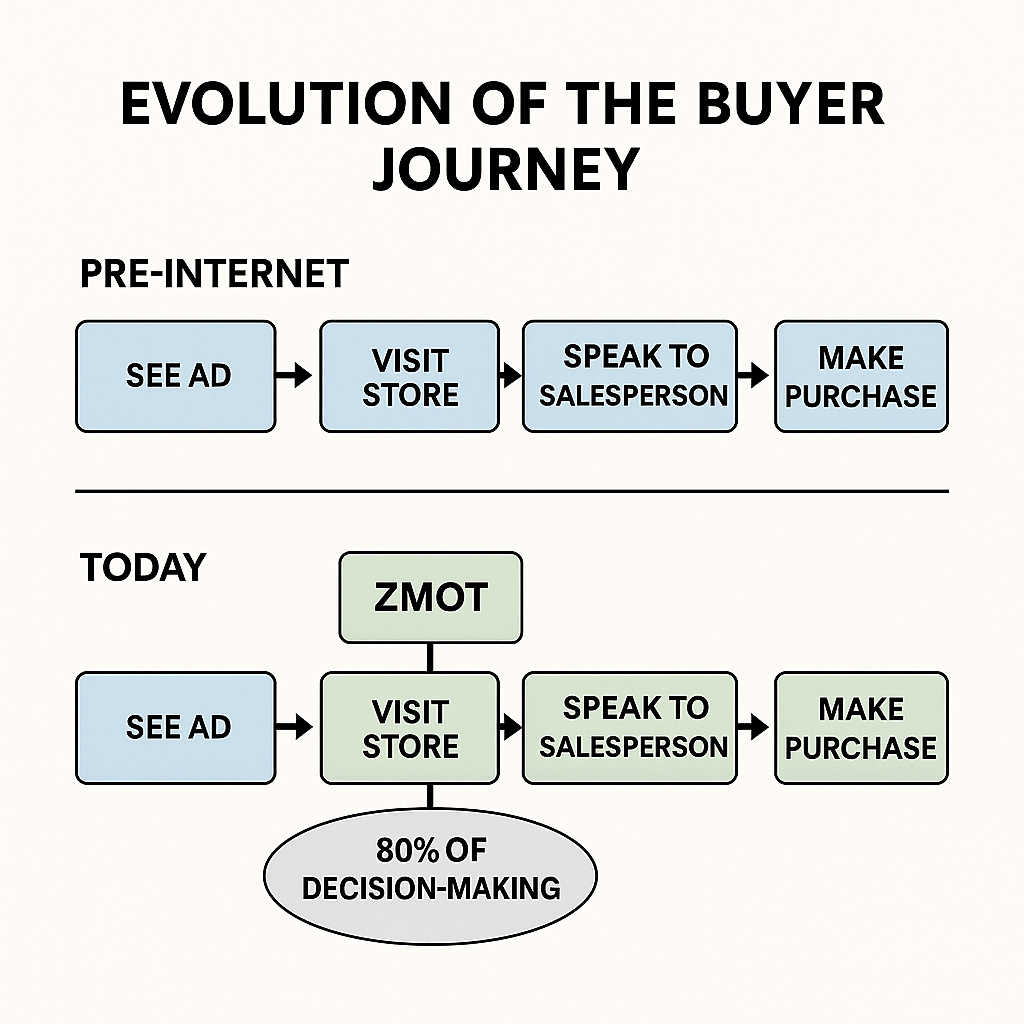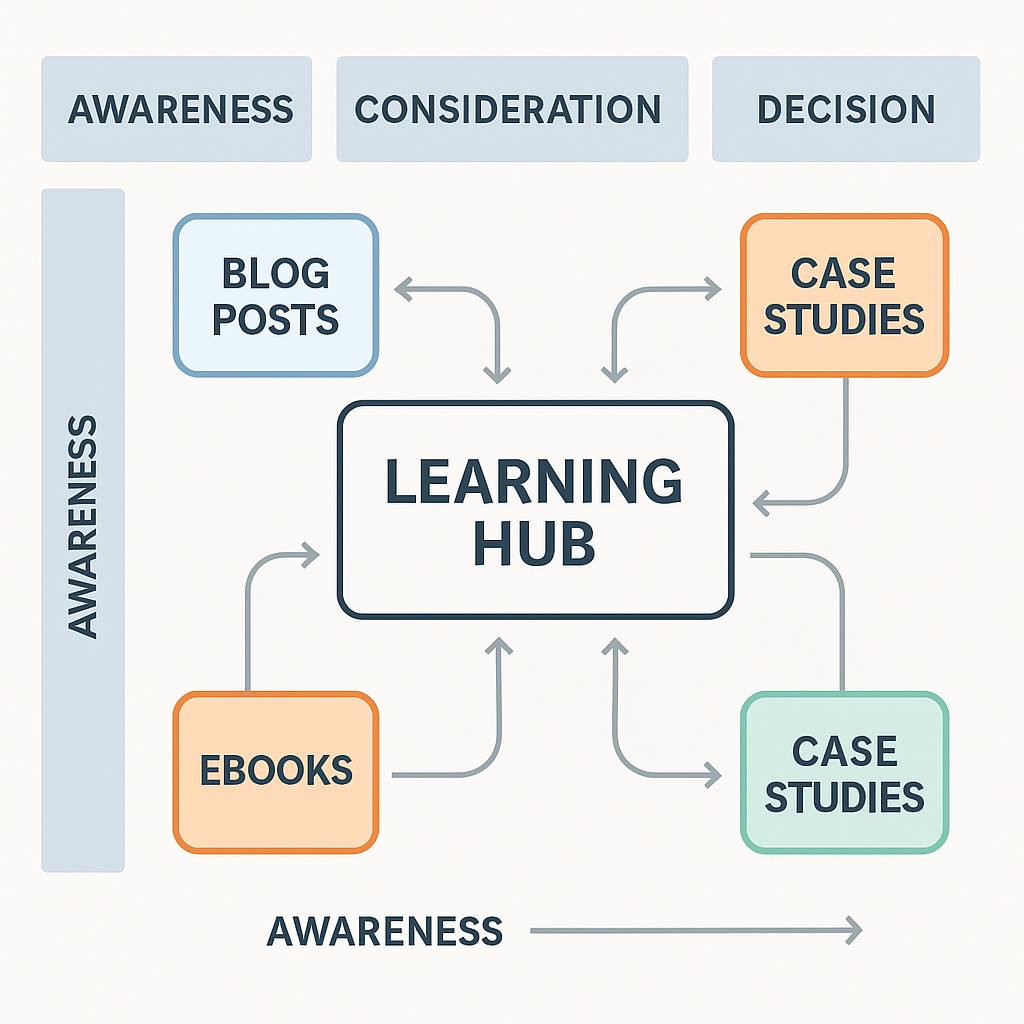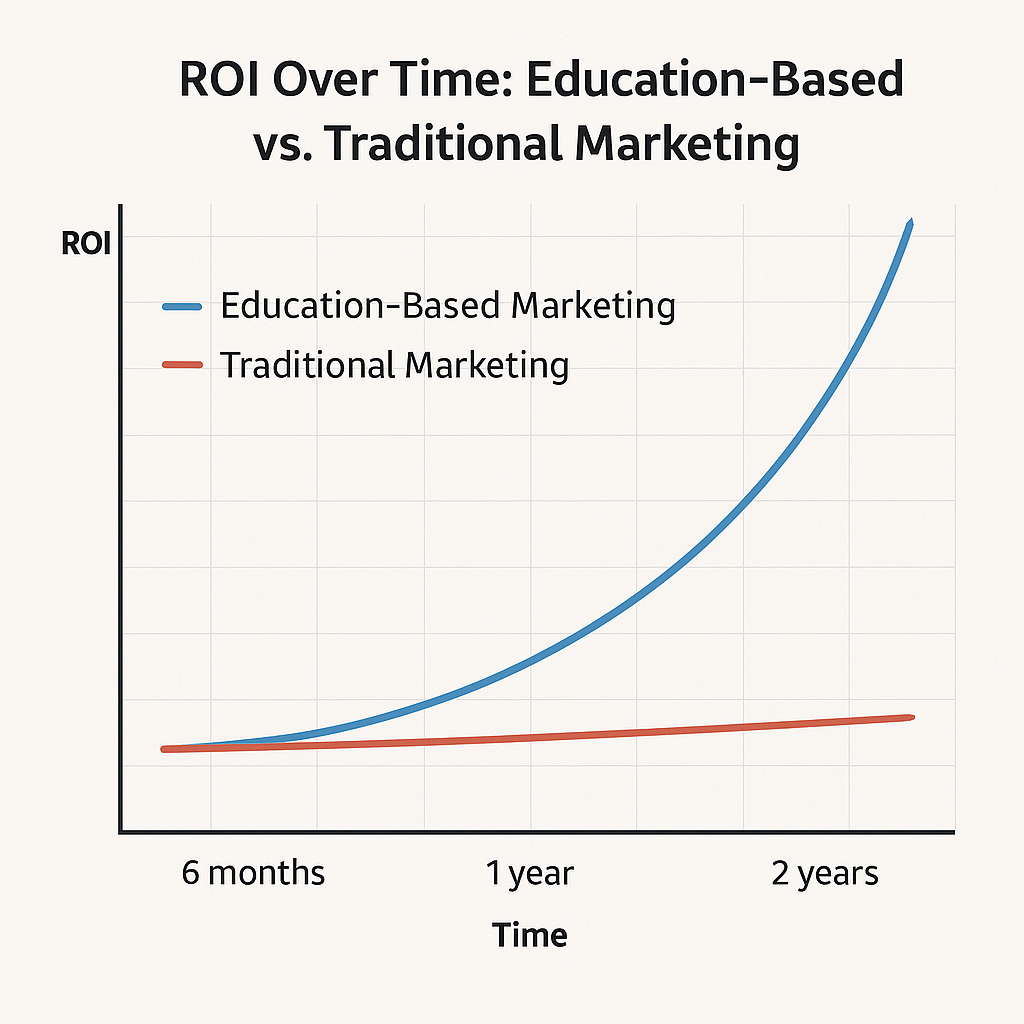Education-Based Marketing: How to Build Trust and Authority Before You Sell
November 17th, 2025
7 min read
By Tom Wardman

Why does everyone keep talking about trust but nobody explains how to build it? What if your biggest competitor became your best source of new leads?
You've done everything right: built the website, published blogs, posted on LinkedIn, yet buyers still ghost you. Why? Because you're competing in a marketplace where 80% of purchasing decisions happen before prospects ever contact you, and most businesses are invisible during that critical research phase.
As a Fractional Marketing Director who's helped companies replace hard-sell tactics with education-based systems, I'll show you exactly how to earn trust before you sell, using proven frameworks like the Big 5 and the Zero Moment of Truth.
Education-based marketing builds trust by teaching buyers before you sell.
Here's what you'll discover: the Zero Moment of Truth that changed buyer behaviour forever, why addressing problems head-on actually increases sales, the 'Big 5' content framework that captures decision-makers, and how to build a learning hub that turns your website into a lead-generating classroom.
What is education-based marketing and why does it work?
Education-based marketing is a strategy that builds trust by answering customer questions honestly and comprehensively before they even consider making a purchase.
According to Google's Zero Moment of Truth research, 80% of buying decisions are made online before prospects ever contact a business, making educational content absolutely essential for influencing purchase decisions.
The principle is simple: when you truly teach, trust naturally follows.
Traditional marketing approaches interrupt prospects with promotional messages. Education-based marketing attracts them with genuinely helpful information they're already seeking.
This approach works because modern buyers have fundamentally changed how they make purchase decisions. You no longer wait for salespeople to educate you—you educate yourself first.
The businesses that recognise this shift and become their industry's best teachers consistently outperform those still relying on traditional promotional tactics.

How education-based marketing addresses the Zero Moment of Truth (ZMOT) in modern buying
The Zero Moment of Truth represents the crucial research phase where you independently evaluate solutions, read reviews, and compare options before engaging with any company.
This shift in buyer behaviour means businesses must provide comprehensive educational resources to influence decisions during this crucial 80% phase of your buying process.
The old buying journey was simple: see advert → visit shop → speak to salesperson → make purchase.
Today's journey includes an additional step that's become the most important: extensive online research between seeing the advert and making contact.
During this Zero Moment of Truth, you:
- Read reviews and case studies
- Compare different solutions
- Watch product demonstrations
- Download guides and resources
- Form strong opinions about companies
This research phase isn't casual browsing—it's serious evaluation where shortlists are created and preferred choices emerge.
Marketing now plays a direct role in the actual sale, not just brand awareness. If you're not consistently publishing educational content online, you might as well not exist in your prospects' minds.
Once you understand how your buyers research, the next question becomes: what information should you actually provide?

Why transparency in education-based marketing beats traditional sales tactics
Transparent communication that acknowledges product limitations and honestly compares alternatives builds significantly more trust than promotional messaging that claims to be perfect for everyone.
Marcus Sheridan's pool company demonstrated this principle by openly discussing the drawbacks of their fibreglass pools, which generated over £2 million ($2.6 million) in sales and higher-quality leads.
Your potential customers are already making comparisons—why not guide them through the process?
When Marcus wrote comparison articles between fibreglass, vinyl liner, and concrete pools, he never claimed his product was better. Instead, he honestly outlined the strengths and weaknesses of each option.
This transparency achieved remarkable results:
- Ranked #1 for over a dozen comparison-related search terms
- Higher conversion rates among qualified prospects
- Reduced sales cycle time
- Improved lead quality
The businesses willing to say what others in their industry avoid consistently win more trust and, ultimately, more customers.
Transparency works because it demonstrates confidence in your offerings while establishing you as an honest broker of information rather than just another vendor pushing their solution.
But what specific topics should you address to build this trust? That's where the Big 5 framework comes in.
The 'Big 5' education-based marketing content topics that drive every buying decision
The 'Big 5' content framework focuses on five crucial topics that influence purchasing across every industry: Cost and Price, Problems, Versus and Comparisons, Reviews, and Best-in-Class.
These topics represent the exact questions and concerns you research independently, making them essential pillars for any education-based marketing strategy.
Here's how each topic works for your business:
1. Cost and Price
Address pricing concerns directly rather than forcing prospects to contact you for basic cost information. Honest pricing discussions build trust and qualify leads before they enter your sales process.
2. Problems
Acknowledge limitations and potential issues with your solution. When you openly discuss problems, prospects trust you more because they know you're being honest about what they might face.
3. Versus and Comparisons
Create content comparing your solution to alternatives. Since you're already making these comparisons, providing unbiased guidance positions you as a trusted advisor rather than a pushy salesperson.
4. Reviews
Showcase customer experiences, both positive and constructive. Authentic reviews demonstrate social proof while acknowledging that no solution is perfect for everyone.
5. Best-in-Class
Recommend competitors when appropriate. Suggesting alternatives when you're not the right fit builds enormous trust and often results in referrals when prospects' needs change.
Once you've identified these five content pillars, the next challenge is addressing the hardest one: problems and limitations.

How to address customer problems in education-based marketing without scaring prospects away
Addressing problems and limitations proactively demonstrates expertise and builds trust rather than deterring potential customers.
The key is following a four-step framework: acknowledge the issue clearly, provide context for why it exists, present current solutions, and reframe with a broader perspective.
Here's the structure that works for you:
- Acknowledge: "Yes, [specific problem] can occur with [your solution]"
- Context: "This typically happens when [specific circumstances]"
- Solution: "Here's what we do to prevent/address this issue"
- Perspective: "Consider this alongside the broader benefits"
The companies that openly discuss potential problems consistently generate higher-quality leads because you appreciate the honesty.
When you feel a business has been transparent about limitations, you're more likely to trust their claims about benefits. This approach also prepares you for realistic expectations, reducing post-purchase dissatisfaction.
Example problem-addressing content might include:
- "Common issues with [your solution] and how to avoid them"
- "When [your solution] isn't the right choice"
- "What could go wrong with [your approach] and our prevention strategies"
Remember: if you don't address problems, your competitors will—and they'll use those problems against you.
Now that you understand how to address problems, let's explore how to create comparison content that actually captures competitor traffic.
Writing comparison content in education-based marketing that turns competitors into traffic sources
Creating honest comparison content allows you to capture search traffic from competitor-related keywords while positioning yourself as an unbiased source of information.
This approach works because you're already making comparisons—businesses are simply guiding you through the process with transparency and expertise.
Effective comparison content follows these principles:
- Never claim your solution is universally better—it isn't, and you know this
- Honestly outline strengths and weaknesses of each option
- Focus on helping you make informed decisions rather than pushing a solution
- Include situations where competitors might be better choices
When done correctly, comparison content achieves multiple objectives:
- Captures search traffic for competitor names
- Builds trust through balanced analysis
- Attracts prospects researching alternatives
- Positions the business as an industry expert
- Often converts prospects initially interested in competitors
The most successful comparison articles rank highly for terms like "[Competitor A] vs [Competitor B]" and "[Your Solution] alternatives," capturing you throughout your research journey.
Once you've earned buyer trust through your Big 5 content, the next challenge is structuring it so prospects can easily find what they need when they're ready to make a decision.
With solid educational content established, the next step is organizing it effectively to guide prospects through their buying journey.
Building an education-based marketing learning hub that converts browsers into buyers
A comprehensive learning hub goes beyond basic blogging by providing in-depth downloadable resources that address your specific needs and questions.
Effective learning hubs organize content around customer outcomes rather than product features, creating a trust-building machine that nurtures you through the entire buying journey.
Key components of successful learning hubs include:
- Complementary blog content that builds on your Big 5 topics
- Diverse content types: eBooks, whitepapers, infographics, case studies, webinars
- Customer-focused organization around needs and pain points, not product features
- Clear categorization with search functionality and related content suggestions
- Lead capture mechanisms that exchange valuable content for contact information
The long-term benefits compound significantly:
- Build qualified email lists through gated content
- Position your business as a thought leader
- Nurture prospects through extended sales cycles
- Support your sales team with educational resources
- Create referral opportunities through valuable content sharing
A well-crafted learning hub isn't just a marketing tool—it's a trust-building machine that transforms casual browsers into loyal customers.
Think of it as planting seeds in a garden. Initially, you won't see much growth, but with consistent care and patience, you'll eventually have a thriving ecosystem that attracts your ideal customers.
The final piece of creating effective education-based marketing is leveraging the expertise already within your organization.

Why every employee should become part of your education-based marketing strategy
Subject matter experts throughout your organization possess valuable knowledge that can transform your content marketing when properly captured and shared.
Companies like Drift discovered that their VP of Sales generated over 2 million blog views annually by sharing his expertise through podcasts and content, proving that the best insights often come from within.
Your team members offer unique perspectives that external content creators simply cannot provide:
- Sales teams understand common objections and frequently asked questions
- Customer service representatives know exactly what problems customers face
- Technical experts can explain complex concepts in relatable terms
- Account managers have insights into what makes customers successful
The key is creating systems that capture this internal knowledge and transform it into educational content.
This might involve:
- Regular content brainstorming sessions with different departments
- Recording internal training sessions for customer-facing content
- Converting customer success stories into case studies
- Transforming technical documentation into educational guides
Every employee becomes a content contributor when you recognize that they interact with customer questions daily.
The most successful education-based marketing strategies leverage the collective expertise of entire organizations, not just marketing teams.
Now that you understand how to create education-based content, let's examine how to measure its long-term impact.
Measuring the long-term impact of education-based marketing
Education-based marketing delivers compounding returns through improved lead quality, shorter sales cycles, higher conversion rates, and increased customer retention.
While this approach requires patience and consistency, businesses that commit to teaching their audience consistently outperform those relying on traditional promotional tactics.
Key metrics to track include:
| Metric | What It Measures | Why It Matters |
|---|---|---|
| Content engagement | Time on page, downloads, shares | Shows content resonates with audience |
| Lead quality | Conversion rates, sales cycle length | Demonstrates trust-building effectiveness |
| Organic search growth | Keyword rankings, traffic increases | Indicates authority building |
| Sales team feedback | Content usage in sales process | Shows practical value for closing deals |
| Customer lifetime value | Retention rates, expansion revenue | Reflects trust and satisfaction levels |

The compounding effect is where education-based marketing truly shines.
Unlike paid advertising that stops generating results when you stop paying, educational content continues attracting and converting prospects for years after publication.
Expect to see:
- Initial improvements in website traffic and engagement within 3-6 months
- Better qualified leads and shorter sales cycles within 6-12 months
- Significant organic growth and industry recognition within 12-24 months
- Sustained competitive advantage and customer loyalty over the long term
The businesses that embrace education-based marketing early consistently outperform those that wait, creating sustainable competitive advantages that become increasingly difficult to replicate.
Where do you go from here with education-based marketing?
You've seen how education-based marketing transforms businesses by building trust before attempting to sell. You now understand the Zero Moment of Truth that governs modern buying behaviour, the Big 5 content framework that addresses every buyer's research questions, and why transparency consistently outperforms promotional tactics.
Most companies still rely on pushy tactics that you no longer respond to—leaving a massive opportunity for businesses willing to become their industry's best teacher.
The path forward is clear: Start answering your customers' questions honestly and comprehensively, embrace transparency about limitations and alternatives, and build a learning hub that positions you as your industry's best teacher.
If you're ready to put education-based marketing into action, I can help. Through my Fractional Marketing Director service and Company Alignment Workshop, I help businesses like yours transform marketing from a cost center into a trust-building machine, because the companies that teach best, sell best.
Topics:


